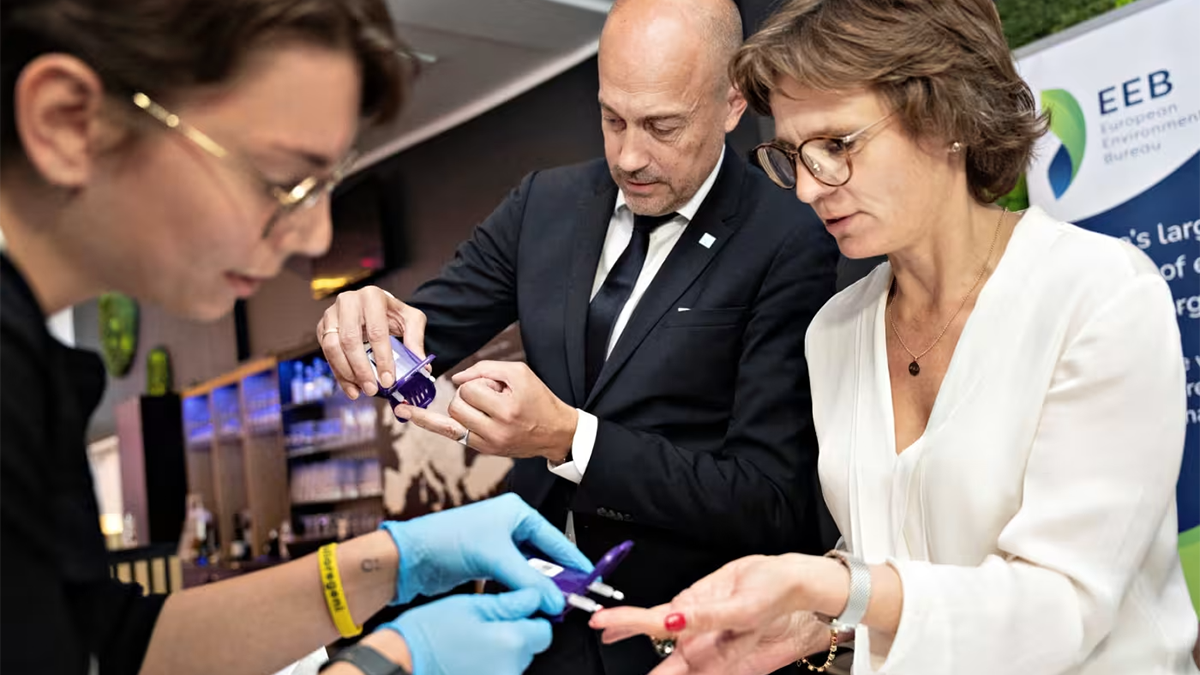All 24 of the top politicians tested [1], who included EU environment commissioner Jessika Roswall and Danish environment minister Magnus Heunicke, were found to be contaminated with PFAS. For half of the EU leaders, contamination exceeded levels [2] beyond which health impacts cannot be ruled out.
Six of the detected PFAS (PFOA, PFOS, PFHxS, PFNA, PFDA and PFUnDA) are already regulated in Europe – either under the EU POPs Regulation or under the REACH Regulation [3] – underscoring their lasting impact and continued threat to human health and the environment.
Led by the Danish Ministry of Environment and Gender Equality, together with the European Environmental Bureau (EEB) and ChemSec, this bold initiative exposes the widespread contamination of PFAS and will hopefully encourage EU leaders to respond quickly to the growing urgency of this pollution crisis.
“The human and economic cost of inaction around PFAS pollution is already staggering, and it’s growing by the day. Decision makers must urgently close the tap, hold polluters accountable and stop this cycle of harm. People need to again have confidence in the water they drink and the food they eat.” Said Patrick ten Brink, Secretary General of the European Environmental Bureau
Between three and eight PFAS chemicals – out of the 13 tested – were detected in the blood of all EU officials tested, with PFOS (which was regulated in 2008) showing the highest concentrations (from up to 17.19 ng/ml) [4]. Half of the individuals tested had PFAS levels exceeding the HBM4EU’s health-based reference value of 6.9 ng/ml for combined exposure to PFOA, PFNA, PFHxS and PFOS. All individuals tested have a total level of PFAS exposure above 2 ng/ml, the level beyond which a specific medical follow-up is recommended by the US National Academies [5].
But there is also reason for hope. One EU leader who had tested their blood previously showed a decline in PFAS levels, which reflects trends observed among the European population for restricted PFAS [6].
“These results prove two things: PFAS contamination spares no one, and regulation works,” said Anne-Sofie Bäckar, Executive Director at ChemSec. “Where bans are in place, levels are starting to fall – clear evidence that strong laws protect people. Now we need EU leaders to finish the job with a universal ban on all PFAS – not just in consumer products – before another generation pays the price for industry’s delay.”
The case for PFAS regulation
The findings highlight both the urgency and the opportunity facing European policymakers. While legacy PFAS restrictions are beginning to reduce exposure, new and replacement PFAS (for PFDA, PFHpS, PFHxS, PFUnDA) continue to accumulate in people’s blood, with concentrations of some compounds rising sharply. This underscores the need for broad, group-based restrictions to prevent regrettable substitutions, where companies replace a regulated harmful chemical with another unregulated (and potentially equally harmful) alternative.
Cleaning up existing contamination could cost the EU up to €2 trillion over the next 20 years – not including the additional €52-84 billion in yearly health-related costs. Preventing further pollution through strong legislation is both possible and cost-effective.
The European Union stands at a critical juncture in the control of hazardous chemicals. On one hand, it is preparing to revise its regulatory framework (REACH), and on the other, it is considering the proposed “universal PFAS restriction” put forward by five Member States.
Today, the European Environment Bureau, ChemSec and more than 100 organisations across Europe launched the Stop PFAS manifesto urging EU leaders to act by supporting the universal PFAS restriction – EU citizens should not have to settle for a partial ban on consumer products only. Delays and loopholes will only prolong the contamination crisis and increase health risks and cleanup costs for future generations.
ADDITIONAL QUOTES FROM TESTED POLICY-MAKERS:
“The results of my blood test illustrate a clear scientific finding: PFAS affects the entire population. They demonstrate the widespread contamination of our environment by these persistent substances. Several PFAS were found in my body. And even though, in my case, the concentrations measured are below the safety thresholds known to date, their mere presence is a reminder of the urgent need to reduce the use of these substances in our daily lives. France is determined to identify the sources of contamination, protect its population and develop its regulations on this topic. These substances have no place in our environment nor in our bodies.” Agnès Pannier-Runacher, French Minister for Ecological Transition, Biodiversity, Forests, the Sea and Fisheries
“It is dramatic to see that, despite existing bans, PFAS are still present in our blood. This shows that these ‘forever chemicals’ are not only a legacy of the past, but an ongoing threat to our health and environment. Belgium fully supports the European Union’s ambition to phase out PFAS, but we believe the process must be accelerated. We owe it to our citizens to act faster, to close the loopholes, and to ensure that polluters are held accountable. The longer we wait, the higher the costs and the greater the risks for future generations.” Jean-Luc Crucke, Belgian Minister of Mobility and Climate
“Like many other citizens across Europe, I have PFAS in my body. I tested positively on 6 out 13 PFAS, including some that are classified as toxic for reproductive health. PFAS pollution is a vital public health issue. This only strengthens my resolve to keep working for stronger action at the European level. My priority is to work for a quick EU-ban on PFAS in consumer products. For industrial uses, we need to move to clean and sustainable substitutes as soon as possible and ensure strict rules that control pollution until alternatives can be found.” Jessika Roswall, European Commissioner for Environment
“Harmful chemicals are in our food, water, and everyday products – but we can act to protect Europeans’ health and nature. That is why I welcome the recent provisional agreement between the European Parliament, Commission, and Danish Presidency for stricter PFAS standards in surface and groundwater. We must also promote safe, sustainable chemicals and phase out the most harmful ones.” Leena Ylä-Mononen, Executive Director of the European Environment Agency
ENDS
CONTACT INFORMATION
- EEB Communications Officer for Chemicals, Beatriz Ortiz Martínez, +34 652 695 003
beatriz.ortiz-martinez@eeb.org (ES/EN/FR)
- ChemSec Communications Officer, Stefan Sterett, +46 70 473 53 67
stefan.sterett@chemsec.org (EN)
ADDITIONAL INFORMATION
Media Briefing > PFAS in Europe: country-by-country updates. Information on the PFAS situation in the EU Member States, for national-level press coverage.
Stop PFAS Manifesto: More than 150 NGOs have united to demand urgent EU action to stop PFAS pollution. In a manifesto launched today, they warn that Europe is facing a PFAS pollution crisis that threatens people’s health and must be treated as an emergency.
The Toxic-Free Europe petition, which has gathered nearly 147,000 signatures from concerned citizens across Europe, calls on the European Union to fully implement its PFAS phase-out plan, including both a universal ban and sector-specific prohibitions.
[1]
List of EU leaders tested: 1 European Commissioner, 11 Ministers, 7 State Secretaries, Deputy Secretaries, or Secretaries of State, 4 Director-Generals or Executive Directors.
- Jean-Luc Crucke (Belgium) – Federal Minister of Climate and Ecological Transition
- Marija Vučković (Croatia) РMinister of Environmental Protection and Green Transition
- Maria Panayiotou (Cyprus) – Minister of Agriculture, Rural Development and Environment of the Republic of Cyprus
- Jeppe Bruus (Denmark) – Minister for Green Transition
- Magnus Heunicke (Denmark) – Minister Environment and Gender Equality
- Jessika Roswall – European Commission – European Commissioner for Environment, Water Resilience and a Competitive Circular Economy
- Andres Sutt (Estonia) – Minister of Energy and the Environment
- Leena Ylä-Mononen – European Environment Agency – Executive Director
- Agnès Pannier-Runacher (France) – French Minister of Ecological Transition, Biodiversity, Forestry, Sea and Fisheries
- Carsten Schneider (Germany) – Federal Minister for the Environment, Climate Action, Nature Conservation and Nuclear Safety
- Peter Javorčík – General Secretariat of the Council of the EU – Director-General for Transport, Energy, Environment and Education
- Aniko Raisz (Hungary) – State Secretary of Environmental Affairs
- Timmy Dooley (Ireland) – Minister of State at the Department of Climate, Energy and the Environment
- Olga Bogdanova (Latvia) – Deputy State Secretary at Ministry of Climate and Energy
- Povilas Poderskis (Lithuania) – Minister of Environment
- Miriam Dalli (Malta) – Minister for the Environment, Energy and Public Cleanliness
- Michel Heijdra (Netherlands) – Director-General for Climate and Energy
- Afke Van Rijn (Netherlands) – Director General Ministry of Infrastructure and Water Management
- Kristoffer Hansen (Norway) – State Secretary, Ministry of Climate and Environment
- Krzysztof Bolesta (Poland) – Secretary of State, Ministry of Climate and Environment
- João Manuel Esteves (Portugal) – Secretary of State for Environment
- Filip Kuffa (Slovakia) – State Secretary, Ministry of Environment of the Slovak Republic
- Uroš Vajgl (Slovenia) – State Secretary, Ministry of the Environment, Climate and Energy
- Hugo Moran Fernandez (Spain) – Secretary of State for the Environment
[2]
In 2020, the European Food Safety Authority (EFSA) adopted an opinion on the risk to human health related to the presence of PFAS in food. In this opinion, EFSA established a group tolerable weekly intake (TWI) of 4.4 ng/kg body weight per week for the sum of PFOS, PFOA, PFNA and PFHxS. Based on this guideline, scientists from the HBM4EU programme have developed a threshold of 6.9 µg/L (or ng/mL) for the combined exposure to PFOA, PFNA, PFHxS and PFOS.
[3]
- PFOA, PFOS and PFHxS are regulated under the EU POPs regulation
- Some uses of PFNA, PFDA, PFUnDA, PFHxA and PFDoDA are restricted under the EU REACH Regulation.
- In addition, PFHpA and PFBS are classified as Substances of Very High Concern (SVHCs) under REACH, but they are not regulated yet.
- The other PFAS (PFBA, PFPeA and PFHpS) are not regulated nor recognised as SVHCs.
[4]
Average levels of Europeans are: 1.67 to 8.06 ng/ml. 8 individuals tested had PFOS levels in their blood above the control limit value (an increased risk of adverse health effects cannot be ruled out), while 1 person had levels above the action limit value (a risk of long-term health effects is possible).
[5]
Recommendation made for the simple additive sum of MeFOSAA, PFHxS, PFOA (linear and branched isomers), PFDA, PFUnDA, PFOS (linear and branched isomers), and PFNA in serum or plasma. US National Academies Guidance: https://nap.nationalacademies.org/catalog/26156/guidance-on-pfas-exposure-testing-and-clinical-follow-up
[6]
From the HBM4EU data collections, a decreasing trend for PFOA and PFOS concentrations can be derived, while this is not the case for other PFASs. https://www.hbm4eu.eu/wp-content/uploads/2022/05/Policy-Brief-PFAS.pdf
Test results in detail:Among the 24 individuals tested, 12 (50%) show PFAS blood concentrations exceeding this 6.9 µg/L reference value.
5 compounds were not detected (PFBA, PFPeA, PFHxA, PFHpA, PFHpS)
The detected PFAS and their concentration ranges (ng/ml) are:
- PFOA: 0.33 – 4.23 (detected in all 24 individuals )
- PFNA: 0.0 – 3.54 (detected in 20 individuals)
- PFDA: 0.0 – 1.19 (detected in 13 individuals)
- PFUnDA: 0.0 – 0.39 (detected in 10 individuals)
- PFHxS: 0.22 – 2.57 (detected in all 24 individuals)
- PFHpS: 0.0 – 0.29 (detected in 2 individuals)
- PFOS: 1.42 – 17.19 (detected in all 24 individuals)
- PFBS: 0 – 0.1 (detected in 1 individual)





